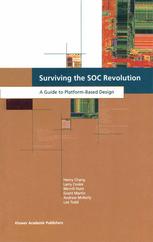

Most ebook files are in PDF format, so you can easily read them using various software such as Foxit Reader or directly on the Google Chrome browser.
Some ebook files are released by publishers in other formats such as .awz, .mobi, .epub, .fb2, etc. You may need to install specific software to read these formats on mobile/PC, such as Calibre.
Please read the tutorial at this link: https://ebookbell.com/faq
We offer FREE conversion to the popular formats you request; however, this may take some time. Therefore, right after payment, please email us, and we will try to provide the service as quickly as possible.
For some exceptional file formats or broken links (if any), please refrain from opening any disputes. Instead, email us first, and we will try to assist within a maximum of 6 hours.
EbookBell Team

4.7
16 reviewsThe aim of Surviving the SOC Revolution: A Guide to Platform-BasedDesign is to provide the engineering community with a thorough understanding of the challenges involved when moving to system-on-a-chip and deliver a step-by-step methodology to get them there.
Design reuse is most effective in reducing the cost and development time when the components to be shared are close to the final implementation. On the other hand, it is not always possible or desirable to share designs at this level, since minimal variations in specification can result in different, albeit similar, implementations. However, moving higher in abstraction can eliminate the differences among designs, so that the higher level of abstraction can be shared and only a minimal amount of work needs to be carried out to achieve final implementation.
The ultimate goal is to create a library of functions and of hardware and software implementations that can be used for all new designs. It is important to have a multilevel library, since it is often the case that the lower levels that are closer to the physical implementation change because of the advances in technology, while the higher levels tend to be stable across product versions.
It is most likely that the preferred approaches to the implementation of complex embedded systems will include the following aspects:
This book deals with the basic principles of a design methodology that addresses the concerns expressed above. The platform concept is carried throughout the book as a unifying theme to reuse. This is the first book that deals with the platform-based approach to the design of embedded systems and is a stepping stone for anyone who is interested in the real issues facing the design of complex systems-on-chip.
From the Preface by Alberto Sangiovanni-Vincentelli